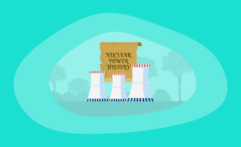10 Most Sustainable Streetwear Brands: The Conscious Consumer’s Guide
Impactful Ninja is reader-supported. When you buy through links on our site, we may earn an affiliate commission.
Learn more
Learn more
.
Hey fellow impactful ninja ? You may have noticed that Impactful Ninja is all about providing helpful information to make a positive impact on the world and society. And that we love to link back to where we found all the information for each of our posts. Most of these links are informational-based for you to check out their primary sources with one click. But some of these links are so-called "affiliate links" to products that we recommend. First and foremost, because we believe that they add value to you. For example, when we wrote a post about the environmental impact of long showers, we came across an EPA recommendation to use WaterSense showerheads. So we linked to where you can find them. Or, for many of our posts, we also link to our favorite books on that topic so that you can get a much more holistic overview than one single blog post could provide. And when there is an affiliate program for these products, we sign up for it. For example, as Amazon Associates, we earn from qualifying purchases. First, and most importantly, we still only recommend products that we believe add value for you. When you buy something through one of our affiliate links, we may earn a small commission - but at no additional costs to you. And when you buy something through a link that is not an affiliate link, we won’t receive any commission but we’ll still be happy to have helped you. When we find products that we believe add value to you and the seller has an affiliate program, we sign up for it. When you buy something through one of our affiliate links, we may earn a small commission (at no extra costs to you). And at this point in time, all money is reinvested in sharing the most helpful content with you. This includes all operating costs for running this site and the content creation itself. You may have noticed by the way Impactful Ninja is operated that money is not the driving factor behind it. It is a passion project of mine and I love to share helpful information with you to make a positive impact on the world and society. However, it's a project in that I invest a lot of time and also quite some money. Eventually, my dream is to one day turn this passion project into my full-time job and provide even more helpful information. But that's still a long time to go. Stay impactful,Affiliate Disclosure
Why do we add these product links?
What do these affiliate links mean for you?
What do these affiliate links mean for us?
What does this mean for me personally?
![]()
Amid growing concerns about the textile industry’s environmental impact, there is pressure to find greener clothes for your wardrobe, from loungewear to streetwear. Unfortunately, fashion greenwashing makes it harder for you and all other consumers to figure out which clothing brands offer the most eco-friendly garments. So, we had to ask: Which are the most sustainable streetwear brands?
The most sustainable streetwear brands are E.L.V. Denim, PANGAIA, and Nothing New, which prioritize low-impact renewable materials, reduce waste, and strive for circularity. In addition, MATE the Label and VEJA reduce carbon emissions and chemical usage.
Whether you are searching for the perfect pair of sneakers or a comfortable streetwear tracksuit to add to your wardrobe without negatively impacting the soil, the water, the animals, and other people, there is a brand for you. So, let’s keep reading to learn more about the most sustainable streetwear brands and how they ensure sustainable, ethical practices.
Here’s How We Selected the 10 Most Sustainable Streetwear Brands
At its inception, streetwear equaled comfortable, street-friendly items such as jeans, baggy tops, and sneakers. The concept has expanded with time, though, to include chic, stylish, fashionable clothing that allows for free movement. Yet, the fast fashion industry has also pushed streetwear to be trendy and easily replaced, leading to the huge adverse environmental impacts of making and landfilling garments, especially when made with certain high-impact materials such as virgin polyester, animal leather, or conventional cotton.
“Sustainable: The ability to be maintained at a certain rate or level | Avoidance of the depletion of natural resources in order to maintain an ecological balance”
Oxford Dictionary
The brands on this list were chosen based on their commitment and actions to promote sustainable practices while reducing the environmental impacts of the textile industry.
They are transparent about their materials, processes, and workforce management within their supply chain.
Some brands focus their efforts on reducing waste and optimizing natural resources while others strive to reduce the carbon footprint of their clothes.
All of these brands share the commitment to reshape the textile industry toward a more sustainable and Earth-friendly sector.
These Are the 10 Most Sustainable Streetwear Brands
Most Sustainable Streetwear Brands
Overall, these streetwear brands are sustainable. Yet, they take various approaches to reduce environmental impacts and uphold ethical standards. Let’s dive into each brand and find out more.
E.L.V. DENIM: Timeless Denim Streetwear Made With 100% Upcycled Materials
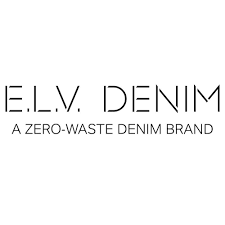
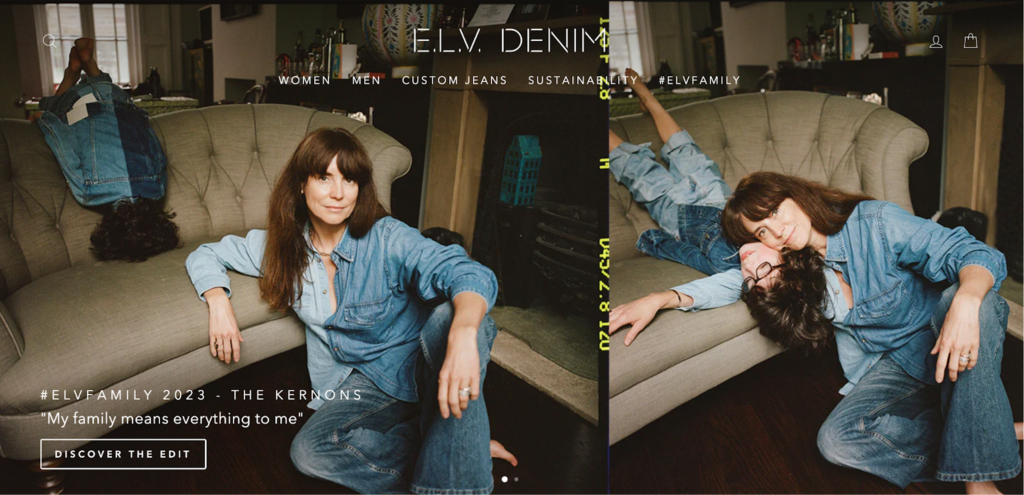
“With considered upcycling and fabric-first curated sourcing, we can meet the global demand for design-led luxury fashion and be kinder to the environment.”
E.L.V. DENIM
🌎
How do they ensure their sustainability?
E.L.V. DENIM‘s commitment to sustainability lies in their zero-waste ethos. They source second-hand jeans and other existing garments, for example, silk scarves and cotton shirts, to upcycle the materials for their denim clothes. All their designs, down to the leather label, are upcycled from existing garments that would otherwise be sent to landfill. Additionally, offcuts are reconstructed as patchwork fabrics and reincarnated as new materials, such as paper, while smaller threads are turned into insulation. They advocate against overconsumption and enable trading in and rotating pre-loved denim jeans via their partnership with Reskinned and Curate & Rotate. Lastly, E.L.V. DENIM source and manufacture their products locally within East London to reduce the climate impact of long-distance shipping.
🌐
How do they ensure their ethics?
E.L.V. DENIM ensures their ethics by keeping their production in the UK with partners who have high social and quality standards. The artisans who work on their denim clothes are paid fairly for their work. As well, E.L.V. DENIM traces most of their supply chain and visits their suppliers regularly.
🤝
Are they part of any giving-back programs?
E.L.V. DENIM works with local schools and universities, providing fabric for textile classes.
🛍️
What is their product range?
- Best for: womenswear, menswear
- Product range: denim, shirts, pants, shorts, jackets, blazers, jumpsuits, playsuits
- Price range: $$$$
- Size range: XS–L
PANGAIA: Comfort-Focused Clothing Made Sustainably With Innovative Textiles
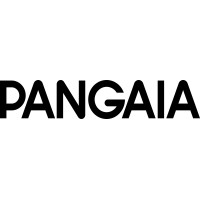
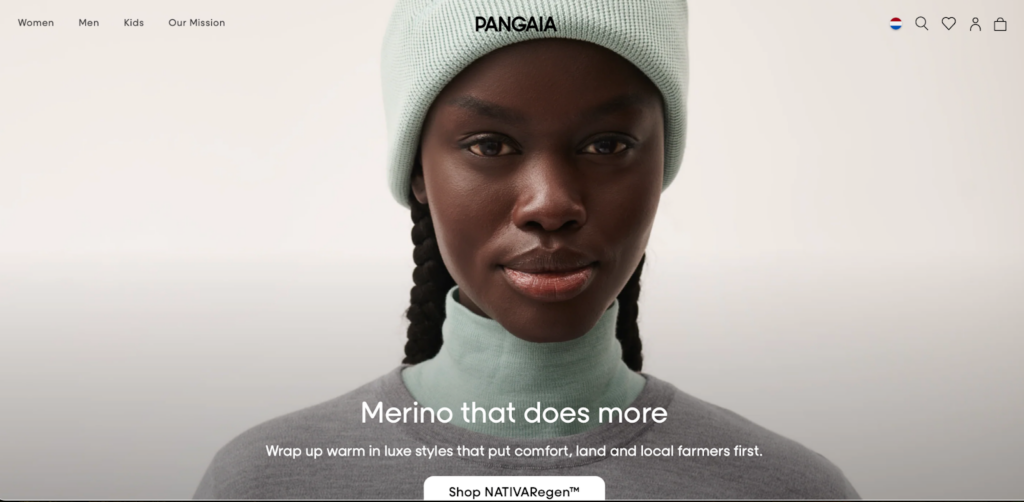
“ Every product we create is born from science and purpose, each solving an environmental problem of the industry. ”
PANGAIA
🌎
How do they ensure their sustainability?
PANGAIA ensures sustainability by diversifying materials options and shifting toward circular systems in which they regenerate nature, design out waste and pollution, and keep products and materials in use. Regarding sourcing materials, they opt for low-impact materials from nature and introduce new and lower-impact alternatives when possible. PANGAIA established their Preferred Material List (PML)—which is diligently assessed based on a variety of criteria, including end-of-life pathways, visibility of the supply chain and raw material inputs, LCA results, certifications, chemical and water intensity, recycled and diverted waste streams, geographical provenance, end-use of the material, and performance—against conventional alternatives. In 2022, 29% of PANGAIA’s collections were made with the top two most sustainable materials on this list, which includes natural fabrics made fully with organic cotton, regenerative cotton, organic linen, organic hemp, organic kapok, regenerative cashmere, and recycled cashmere. They also make use of innovative materials to replace high-impact traditional fabrics, for example, plant-based, ethically-sourced FLWRDWN™ to replace goose and duck down, FRUTFIBER™ to replace conventional cotton, or bio-based material MIRUM® to replace animal and synthetic leather. Further down the life-cycle in the manufacturing stage, PANGAIA applies innovative treatments to reduce waste and water use. These include AIR INK®, miDori® bioWick, and the bioengineered dye technology COLORFIX.
🌐
How do they ensure their ethics?
PANGAIA binds suppliers in a Code of Conduct that covers all of the ILO’s Four Fundamental Freedoms principles. They also make statements regarding Diversity and Inclusion, Modern Slavery, Child Labour & Young Workers Policy, and Human Rights Policy. Furthermore, they trace most of their supply chain, including all of the final stages of production. In 2022, they extended their transparency by mapping and publishing their Tier 1 subcontractors and Tier 2 suppliers while having 95% of their suppliers audited by a third party.
🤝
Are they part of any giving-back programs?
PANGAIA has been part of various philanthropic programs since their inception. They plant a mangrove tree for every product sold. PANGAIA is also a member of 1% for the Planet, meaning that with every product you buy from them, a sum is going to support the planet in one way or another. For example, through their partnership with Milkywire, PANGAIA launched two grassroots funds, Tomorrow Tree and Bee the Change, working collaboratively with communities in various conservation initiatives. They also partner with Coral Gardeners, an organization dedicated to saving our oceans’ coral reefs, which are in rapid decline. Additionally, they provide financial and in-kind support for humanitarian causes such as support for refugees and displaced people, racial justice and LGBTQIA+ rights, frontline workers, and young people.
🛍️
What is their product range?
- Best for: womenswear, menswear, kidswear
- Product range: hoodies, knitwear, outerwear, sweatshirts, tops, T-shirts, pants, denim, shorts, activewear, gloves, hats, socks, accessories
- Price range: $$$$
- Size range: XS–XL
Nothing New: Streetwear of Luxury Quality Built With Sustainable Materials

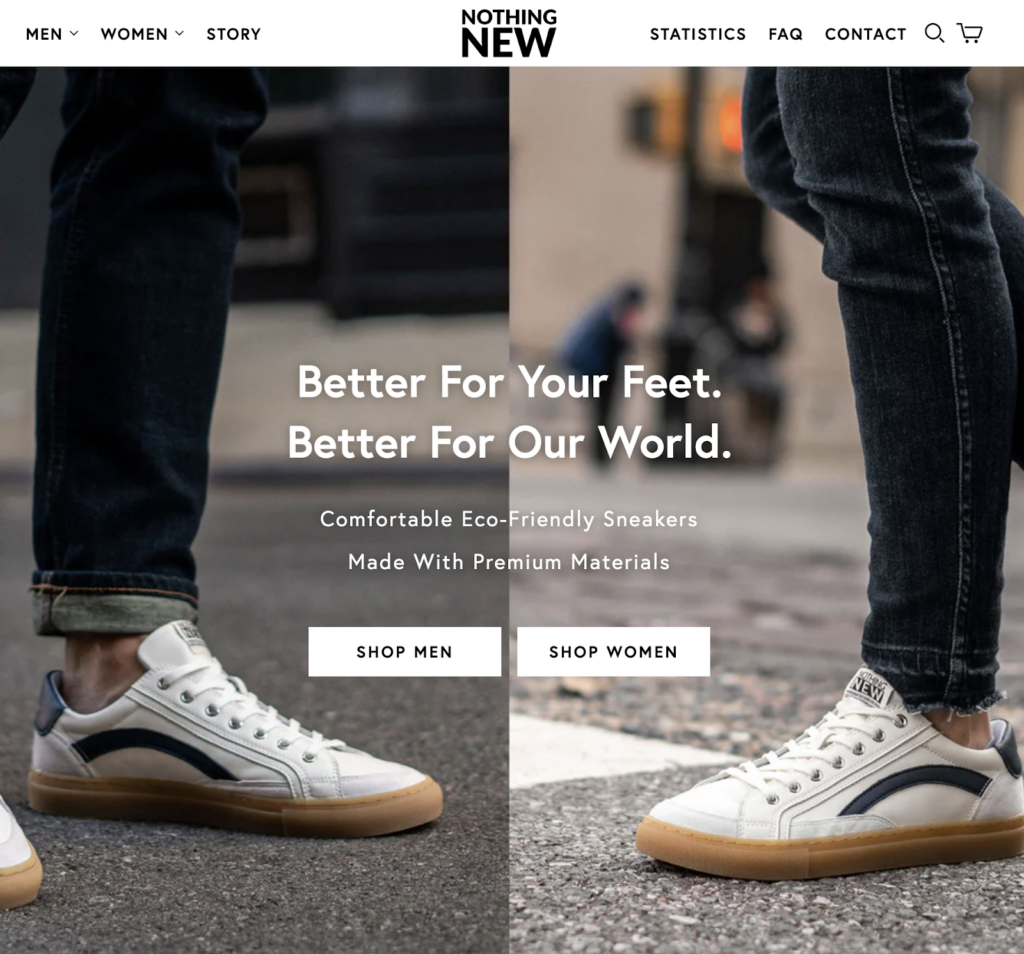
“By helping develop best-in-class sustainable products and investing in programs to minimize our environmental footprint, we hope to raise the bar for what customers expect from brands and contribute to the change we.”
Nothing New
🌎
How do they ensure their sustainability?
Nothing New ensures sustainability by lowering their carbon footprint. They achieve this firstly by prioritizing recycled materials to make their streetwear and packaging. Their Beyond CanvasTM is canvas material based entirely on post-consumer recycled plastic with Global Recycle Standard (GRS) certification, reverting on average 5.6 plastic water bottles away from landfills per pair of sneakers. Nothing New also rescues leather to make Beyond LeatherTM, another upper sneaker material certified by GRS. The suede leather used in some of their shoes is manufactured chrome-free by a tannery with a gold standard from the Leather Working Group. Further down the life-cycle in the manufacturing stage, Nothing New reduces their environmental impacts by avoiding cement and vulcanized construction of the shoes, which involves chemical-based glues and sulfur emissions. Instead, they opt for stitch construction, creating a more flexible and durable bond between the outsole and upper, extending the shoes’ lifespan. Beyond making long-lasting products, Nothing New also runs the Virtuous Circle Program, encouraging consumers to send in pre-loved shoes to be donated or disassembled for material recycling. Lastly, Nothing New offsets all their emissions in projects expanding forests that capture and store carbon, generating wind energy, and replacing fossil fuels with biofuels.
🌐
How do they ensure their ethics?
Nothing New partly traces their supply chain, including the final stage of production, as well as some of the second stage.
🤝
Are they part of any giving-back programs?
Nothing New donates used shoes.
🛍️
What is their product range?
- Best for: menswear, womenswear
- Product range: low-top streetwear, high-top streetwear, socks, accessories
- Price range: $$
- Size range: XS–XXL
MATE the Label: Clean From Seed to Skin

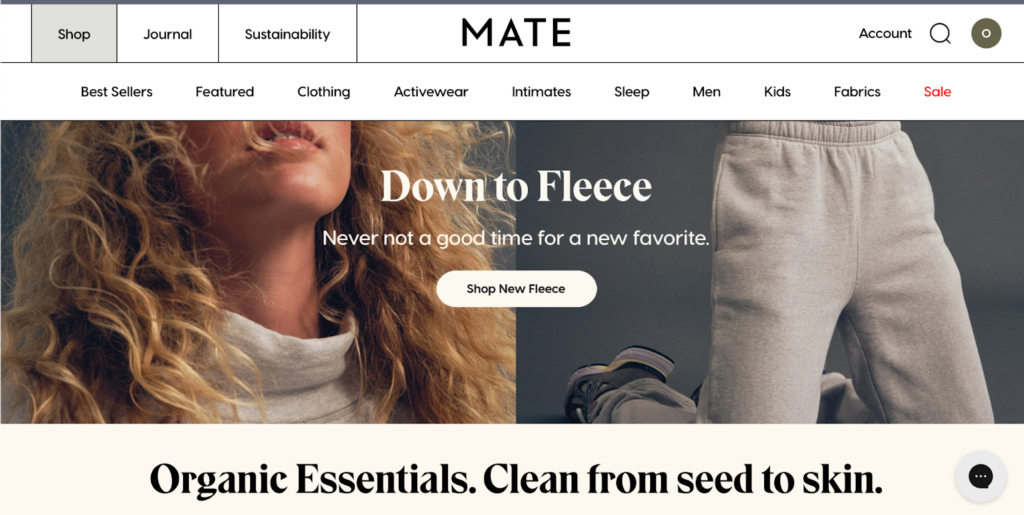
“To provide people everywhere with essentials that are clean from seed to skin.”
MATE the Label
🌎
How do they ensure their sustainability?
MATE the Label ensures sustainability by sourcing low-impact fibers, reducing carbon footprints, and recycling. Specifically, they opt for yarns based on plant fibers, including linen, hemp, and climate-beneficial cotton. Furthermore, they use non-toxic dyes to color their apparel. Regarding their carbon footprint, MATE the Label manufactures locally (within 15 miles of their office) to reduce transportation emissions. The brand diverts their textile waste (pre- and post-consumer) into making new products. They also have B Corporation and Climate Neutral certifications.
🌐
How do they ensure their ethics?
MATE the Label has a Code of Conduct covering some ILO Four Fundamental Freedoms principles. Specifically, they do final production in US factories where they have banned, since day 1, the piece rate pay—a practice that often leads to wages below minimum wage and unsafe working conditions. They commit to creating safe, comfortable, and fair working environments for everyone in their supply chain, including farmers, garment workers, and recyclers. They also make regular visits to their suppliers.
🤝
Are they part of any giving-back programs?
In 2021, MATE the Label donated 1% of sales to nonprofit partners that are committed to saving the planet. On Giving Tuesday in 2021, they upped the donation from 1% of every purchase to 5%. Since their partnership with BEAM Impact, MATE the Label’s customers can choose which organizations they would like their donations to go to.
🛍️
What is their product range?
- Best for: minimalistic, versatile clothes for women
- Product range: sweaters, dresses, pants, hoodies, sweatshirts, maternity wear, blouses, T-shirts, jumpsuits, underwear
- Price range: $$
- Size range: XS–XL
VEJA: Sneakers Made With Innovative, Low-Impact Materials
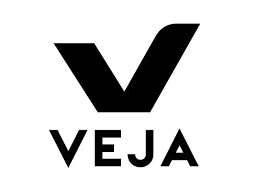

“VEJA is walking on two feet: ecology and social justice on one side, design on the other. We never compromise between the both of them.”
Sebastien Kopp, Co-Founder of VEJA
🌎
How do they ensure their sustainability?
VEJA ensures sustainability by opting for a high proportion of low-impact materials and reducing textile waste. In 2020, recycled polyester and organic cotton made up nearly 76% of their sneaker materials. They also use other eco-friendly materials, including organic jute and recycled cotton. With leather, the traditional shoe material, VEJA strives to improve traceability and transparency. All their tanning partners are Gold certified by the Leather Working Group which promotes sustainable environmental practices in the leather industry. VEJA discloses the total carbon emissions released throughout their supply chain and the equivalent carbon footprint of various models. By working out the proportion of their emissions, they identify the hot spots and reduce their footprints in multiple ways, including using renewable energy, improving the most-polluting products (leather-based streetwear), reducing air freight for transportation from factories to retailers, and taking the train as the main transporting methods for team members. In June 2020, they launched their VEJA x Darwin project, a test hub for cleaning, repairing, and recycling old streetwear, keeping materials longer in circulation while reducing waste and carbon footprint.
🌐
How do they ensure their ethics?
Fair trade is one of the three fundamental pillars VEJA is built on. They work directly with producers and use annual contracts to guarantee income and a reasonable price for producers. Workers who manufacture VEJA streetwear are well compensated and live in normal conditions. Their Supplier Code of Conduct covers the ILO’s Four Fundamental Freedoms principles. VEJA also traces most of their supply chain and visits their suppliers regularly.
🤝
Are they part of any giving-back programs?
VEJA partners with Log’ins (Logistics & Insertion), an organization that employs people with light disabilities and promotes their social inclusion. In 2022, more than 200 employees recognized as disabled workers were supported by Log’ins.
🛍️
What is their product range?
- Best for: womenswear, menswear, childrenswear
- Product range: Streetwear
- Price range: $$
- Size range: XS–XXL
Nudie Jeans: Sustainable Denim Jeans Come With Free Repair for Life

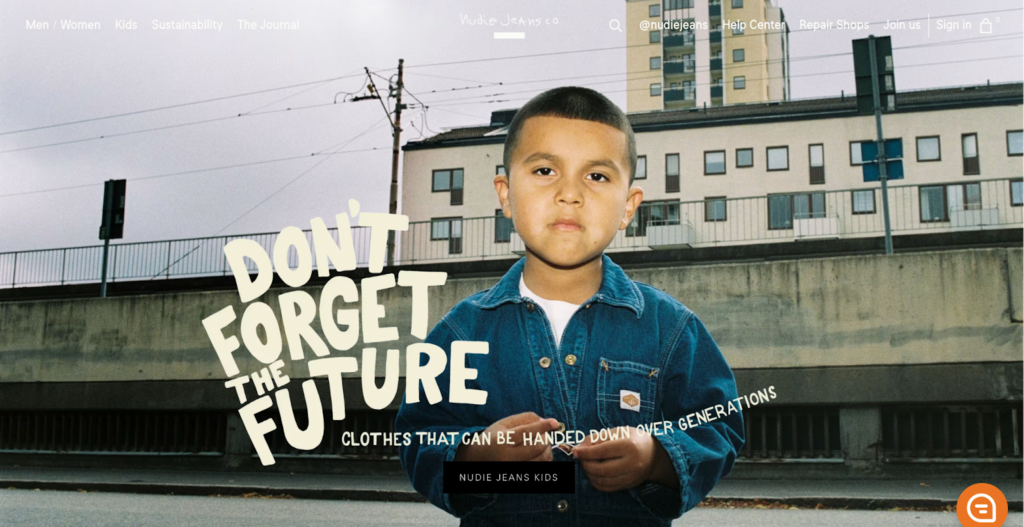
“When we started Nudie Jeans in 2001, we decided that environmental awareness and human rights would permeate everything we did.”
Maria Erixon, Co-Founder of Nudie Jeans
🌎
How do they ensure their sustainability?
Nudie Jeans promotes sustainability by sourcing a high proportion of low-impact materials, including organic cotton and recycled cotton. Of all fibers they used in 2022, 95,6% were organic, certified, or recycled fibers. 2022 was the sixth full year in which Nudie Jeans used exclusively certified organic cotton in all their cotton products. Additionally, they ensure their sustainability by using renewable energy in their supply chain to reduce their carbon footprint. Lastly, Nudie Jeans strives to extend the life-cycle of denim jeans with initiatives to repair, reuse, and recycle. They offer free repair of Nudie Jeans no matter when or where they are bought at one of their Repair Shops or Repair Partners or by sending jeans owners a free DIY repair kit. In 2022, they repaired 65,386 jeans for free. Nudie Jeans also offers a 20% discount after you send in your pre-loved jeans to be washed, repaired, and resold in their Reuse range. In 2022, they sold 3,984 pairs of Reuse jeans. When repairing and reusing are not possible, they put the fabrics, reclaimed from used garments, production seconds, and leftovers, into recycling projects.
🌐
How do they ensure their ethics?
Nudie Jeans strives to be as transparent as possible about how their products are made. The full list of all their suppliers is available for download on their website. Most of these suppliers are certified by Fair Wear Foundation, Fairtrade International – Small Producers Organisations, Global Organic Textile Standard (GOTS), and Sedex Members Ethical Trade Audit – SMETA Best Practice Guidance, ensuring living wages and fair working conditions for workers making Nudie Jeans denim jeans.
🤝
Are they part of any giving-back programs?
Nudie Jeans has donated directly to various charity initiatives. For example, in 2022, they made monetary and jeans donations to UNICEF (to Ukrainian children and their families), Sustainably Crafted Clothing, Räddningsmissionen (The Rescue Mission), Thread Together, and Whitechapel School.
What is their clothing range?
- Best for: menswear, womenswear
- Product range: shirts, hats, scarves, pants, coats, jackets, blazers
- Price range: $$$
- Size range: XS–XL
Stella McCartney: Luxurious Fashion Streetwear Made Ethically and Sustainably
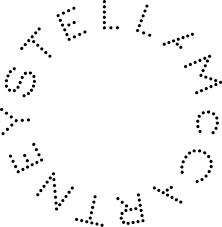
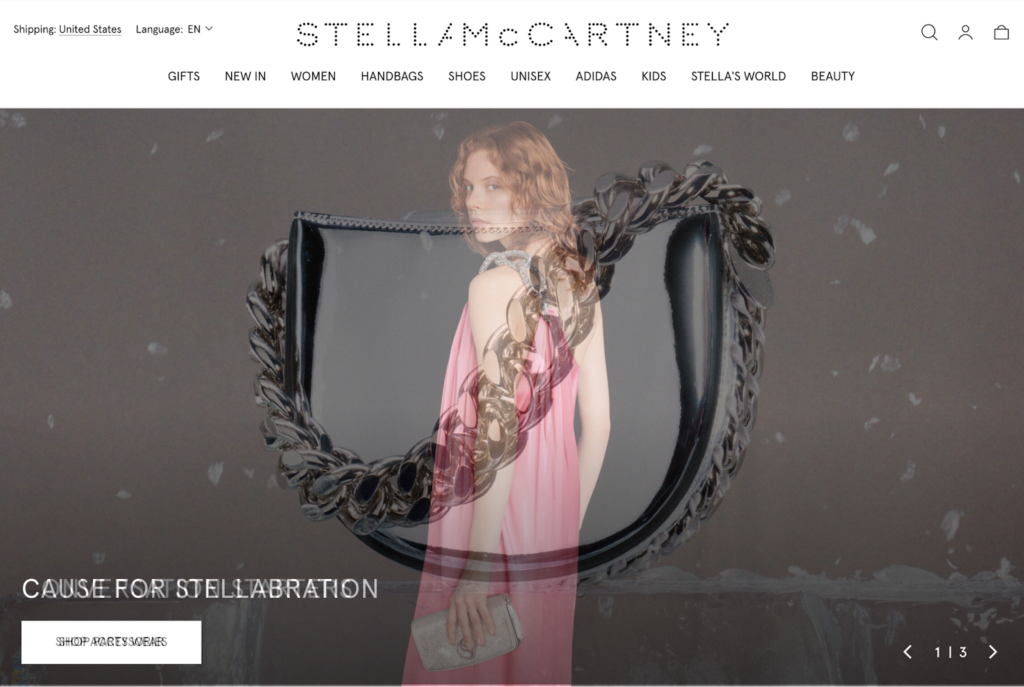
“We are committed to being an ethical, modern and honest company without compromising on luxury or quality.”
Stella McCartney
🌎
How do they ensure their sustainability?
Stella McCartney ensures sustainability by making use of the most cutting-edge and progressive materials that aim to reduce the environmental impact on the planet and are always cruelty-free while following the principles of circularity. They use a medium proportion of eco-friendly and innovative materials, including GOTS-certified organic cotton, cashmere from 100% recycled waste Re.Verso™, and low-impact plant-based alternative materials (BananaTex®, VEGEA, Mylo™, MIRUM®). Specifically, they invested in the parent company that makes MIRUM®, an entirely plastic-, fossil fuel- and water-free alternative to animal leather. Also, their Frayme Mylo™ is the world’s first-ever luxury bag made with vegan leather crafted from mycelium, the root-like structures of fungi. Further down the life-cycle, Stella McCartney employs technological advances to trace their products, lower their manufacturing impact, and increase their circularity. Additionally, they exclusively use paper that is either FSC-certified or made from at least 50% recycled content in their packaging. In 2014, the brand launched Clevercare—a garment labeling system covering five simple areas of clothing care: washing, temperature, drying, ironing, and dry cleaning to help extend the life of garments, decrease the number of pieces that end up in landfill, and reduce life-cycle environmental footprint.
🌐
How do they ensure their ethics?
Stella McCartney commits to transparency across supply chains through diligent reporting, measuring, and tracking. Stella McCartney is a member of the Ethical Trading Initiative (ETI), a human rights organization driving force in ethical trade. They also trace most of their supply chain. Additionally, Stella McCartney uses lambswool and sheep wool certified with Responsible Wool Standard, appropriately addressing the welfare of sheep (and their calves) and the land they graze on.
🤝
Are they part of any giving-back programs?
Stella McCartney partners with and supports many charities, including but not limited to BioPlanet, Million Trees Miami, Naked Heart Foundation, Meat Free Monday, and Sea Shepherd.
🛍️
What is their product range?
- Best for: womenswear, menswear, kidswear
- Product range: shirts, skirts, denim, sweaters, swimwear, dresses, pants, jackets, blazers, hoodies, knitwear, tops, blouses, T-shirts, underwear, socks, shorts, jumpsuits, playsuits, shoes, accessories, plus-size
- Price range: $$$
MoEa: Bio-Sneakers Made From Fruits and Plants

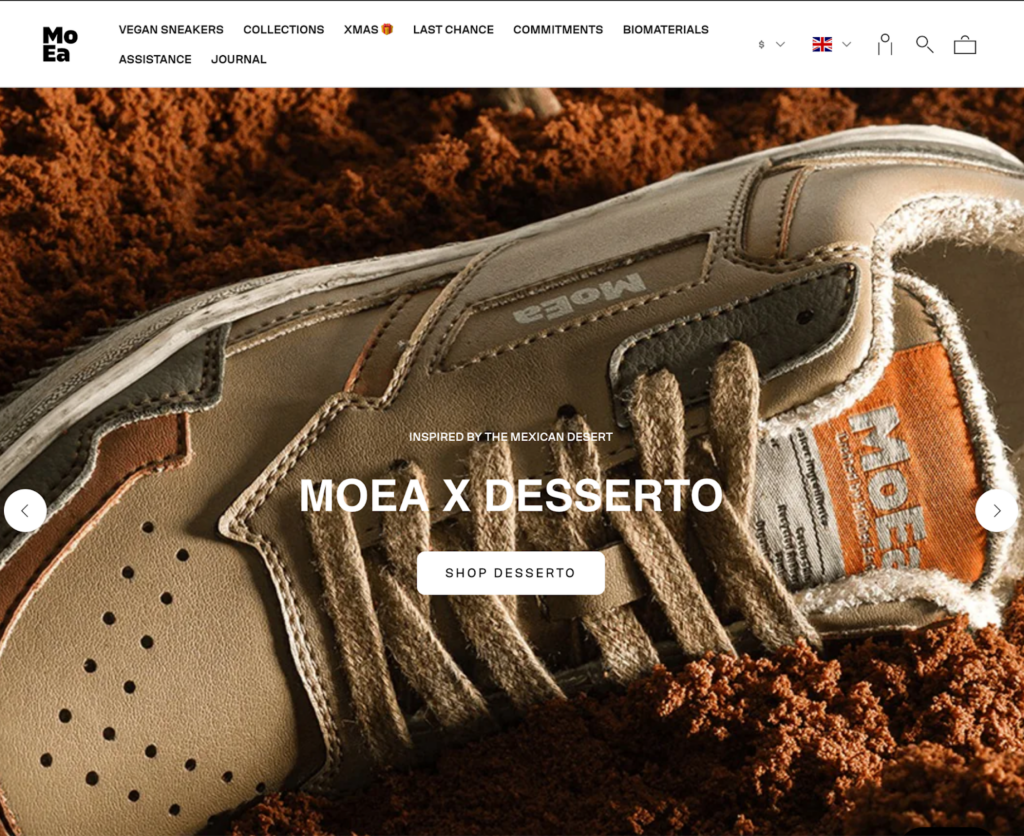
“We’ve launched MoEa to create Streetwear that offer the same level of style and comfort you’d expect to see in your favourite leather pair, whilst ensuring that the planet isn’t some sort of a meaningless afterthought and that animals aren’t treated with cruelty.”
MoEa
🌎
How do they ensure their sustainability?
MoEa ensures sustainability by replacing leather with biomaterials to stay cruelty-free while reducing their carbon footprint. The biomaterials of their choice are made with agricultural waste and a stabilizer of either cotton or recycled/bio-based polyurethane. MoEa uses a range of these bio-based vegan leathers, including Piñatex, AppleSkinTM, CactusSkin, CornSkin, and GrapeSkin. Beyond shoe uppers, the brand sources recycled materials for other parts, for example, 70% recycled bamboo for the lining and 40% recycled rubber for the soles. Additionally, they calculate and disclose the life-cycle carbon footprint of each type of biomaterial used in their streetwear. Their life-cycle assessment, made by certified agency Sami, shows that a MoEa sneaker emits on average 5kg CO2 eq. In comparison, the estimated carbon impact of a pair of bovine leather shoes is over 60 kg CO2 eq.
🌐
How do they ensure their ethics?
MoEa ensures their ethics by using traceable materials and holding the last stage of production in Portugal, a low/medium risk country for labor abuse. They also visit their suppliers. Regarding animal welfare, MoEa avoids animal cruelty practices by making their entire product range vegan, certified by PETA.
🤝
Are they part of any giving-back programs?
MoEa is a member of 1% for the Planet, donating one percent of their sales to environmental causes. They also help protect forests with WWF France.
🛍️
What is their product range?
- Best for: unisex
- Product range: Streetwear, socks
- Size range: XXS–XXL
Baukjen: Womenswear Designed for Circularity and Made Sustainably

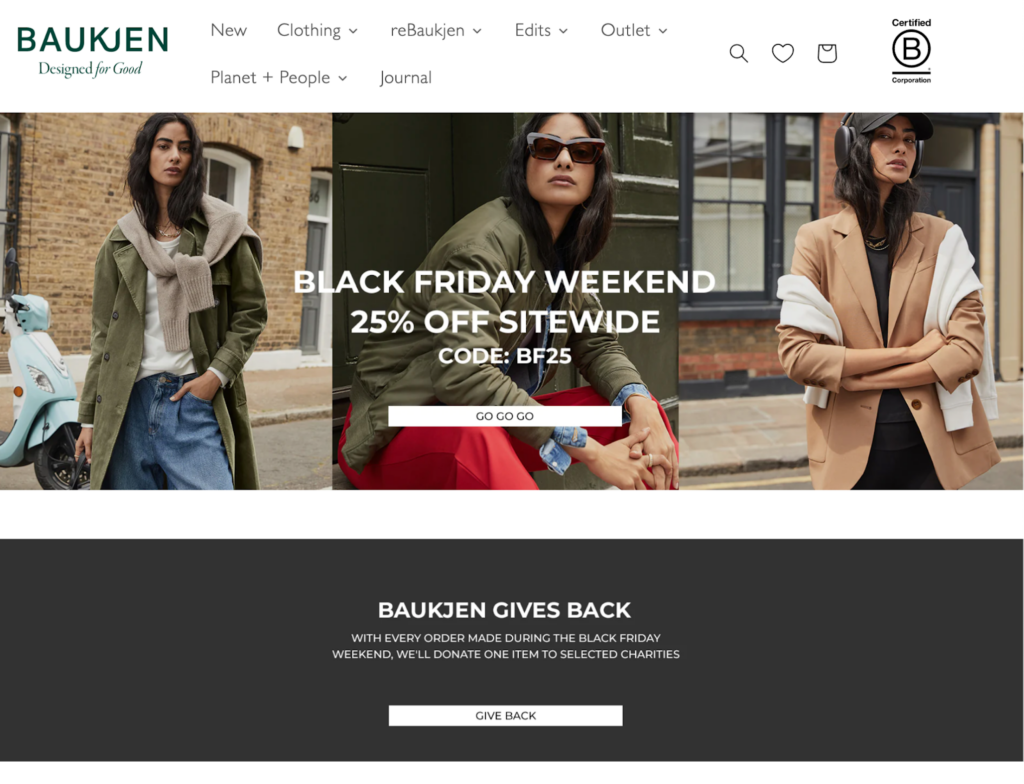
“Our collections are designed for the modern woman struggling with a busy lifestyle. Effortless style is our design signature, premium quality is our standard so our clothes can be worn year after year.”
Baukjen
🌎
How do they ensure their sustainability?
Baukjen ensures sustainability by swapping planet-unfriendly materials for more responsible ones, cutting down environmental impacts throughout their supply chain, and moving toward a circular model. They lower their impact and contribute to a circular materials economy by increasing the proportion of recycled fibers (Ecotec recycled cotton, recycled sheep wool, recycled cashmere, Newlife recycled polyester, recycled down) and regenerative fibers. For example, in the second quarter of 2023, 98.6% of the materials used were from responsible sources with traceable origins, while 98.2% of the fibers used have a proven lower environmental impact. With high-impact textiles like leather, Baukjen reduces the adverse impacts by opting for exclusive by-products of food production and sourcing from tanneries that use vegetable extracts, such as tree bark and leaves, instead of nonrenewable metal salts. Further down the life-cycle in the manufacturing stage, they continue to lower the impacts by reducing water usage, using 100% renewable energy in offices and warehouses to decrease their carbon footprint, and minimizing manufacturing waste. For example, the water consumption and carbon emissions in the second quarter of 2023 were 47% and 31% lower than the same quarter in 2020, respectively. Baukjen is also a Zero Waste business, meaning that over 90% of their “waste” is neither landfilled nor incinerated. Once finished, their garments are shipped in 100% plastic-free, recyclable, and biodegradable packaging made from a recycled paper mix certified by FSC or PEFC. Lastly, Baukjen strives toward circularity through their re-commerce initiatives: Pre-Loved, Rental, and Care and Repair.
🌐
How do they ensure their ethics?
Baukjen ensures their ethics by maintaining a high level of transparency regarding their factories and the impacts of their garments. They share the list of their factories, from Tier 1 to Tier 3 suppliers. Their Code of Conduct, signed by all direct suppliers (Tier 1) and some indirect suppliers (Tier 2), covers all of ILO’s Fundamental Freedoms principles. They visit their factories regularly and enforce third-party audits. Additionally, they offer insights into the sustainable attributes of each item in their collection, such as the impact, the traceability, the carbon emission, or the nature of the fibers used.
🤝
Are they part of any giving-back programs?
Baukjen gives at least 10% of their annual profits to charities, including NHS Charities Together, GOSH, Oxfam, Strut Safe, World Land Trust, Prince’s Trust, and Birth Companions. Their team is offered two days per year to volunteer at charities of their choice. For three years running, they swapped deals for good deeds over the Black Friday Weekend, opting instead to donate profits or clothing over the four-day shopping bonanza to a range of deserving charities, such as the UK women’s charity Smart Works.
🛍️
What is their product range?
- Best for: womenswear
- Product range: shirts, blouses, sweatshirts, cardigans, dresses, tops, jackets, blazers, outerwear, T-shirts, vests, jeans, pants, skirts, knitwear, jumpsuits, joggers, pajamas, underwear, tights, maternity wear
- Price range: $$
- Size range: XS–XXL
Womsh: Sneakers Designed and Manufactured Entirely in Italy
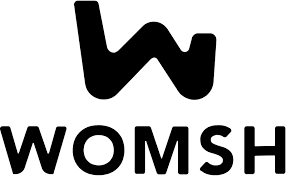

“Womsh (Word Of Mouth Shoes): starting with our name, with each word, we want to promote a more conscious and environmentally friendly purchasing philosophy. We would like to create a tribe of people who think, choose and start to change the world with their small yet effective everyday gestures.”
Womsh
🌎
How do they ensure their sustainability?
Womsh prioritizes sustainability by sourcing a medium proportion of eco-friendly textile and packaging materials, opting for low-impact production, and implementing incentives to reduce their carbon footprint. Firstly, they lower their environmental impacts by using 100% recycled cardboard for packaging and transitioning into using vegan leather AppleSkinTM (50% apple fiber and 50% Polyurethane) in their streetwear. Secondly, they opt for a metal-free tanning process for the leather used in the uppers of some shoe models and for the lining of the entire collection, guaranteeing safety for people’s health and for the environment. Lastly, their carbon footprint reduction incentives include relying on clean and renewable sources for 90% of the energy needed in the main manufacturing factory, keeping sourcing and manufacturing locally within Italy to avoid long-distance transportation and its associated carbon emission, and offsetting carbon emissions with the project Zero Impact under their partnership with LifeGate.
🌐
How do they ensure their ethics?
Womsh traces most of their supply chain and ensures payment of a living wage for some suppliers. The workers who produce their shoes are paid according to European standards and provided with a safe and healthy working environment.
🤝
Are they part of any giving-back programs?
Womsh participates in recycling projects where their sneakers are collected and taken apart so that the upper parts can be turned into granular material. Such materials are used in children’s playgrounds as anti-shock flooring.
🛍️
What is their product range?
- Best for: menswear, womenswear
- Product range: Streetwear
- Price range: $$$
- Size range: XS–XL
Why Is It Important to Buy Products Made of More Sustainable Fabrics
It is important to buy products made of more sustainable fabrics because a sustainable textile industry has a lower carbon footprint, helps save natural resources, and is better for forests, animals, and humans.
Buying Sustainable Fabrics Reduces Your Carbon Footprint
The production of clothing and footwear is estimated to contribute 10% of global greenhouse gas emissions—more than all international flights and shipping combined. If the fashion industry were a country, it would be the fourth largest emitter of carbon dioxide.
One way to reduce the carbon footprint of the clothes you buy is to opt for sustainable fabrics. Sustainable fabrics, which are often made with natural or recycled fibers, have relatively low carbon footprints compared to petroleum-based fabrics. For example, organic cotton made in the US has a carbon footprint of 2.35 kg CO2 (per ton of spun fiber)—a quarter of polyester’s carbon footprint.
Buying Sustainable Fabrics Reduces Demand For Natural Resources and Waste Management
The textile industry uses water and land to grow cotton and other fibers. It is estimated that 79 billion cubic meters of water were used for the sector worldwide in 2015. For example, producing a single cotton T-shirt requires as much water as one person drinks for 2.5 years (2,700 liters of fresh water).
Worse yet, the textile economy is vastly more linear than circular: the largest amount of resources used in clothes ended up in landfills (instead of being recycled to remake clothes). According to a report by the Ellen MacArthur Foundation,
- Less than 3% of materials used in the textile economy in 2015 came from recycled sources.
- In other words, more than 97% of resources used in making clothes are newly extracted.
When clothing items are disposed of within a short period of time—under a year in the case of half of the fast fashion clothes—the natural systems that provide raw materials for fabrics don’t have enough time to recover and regenerate, which could lead to ecological breakdown.
Sustainable fabrics are made with less water and emissions while lasting longer:
- Because they are durable, you don’t need to buy new clothes too often.
- Thus, you help reduce the pressure to extract more resources for making new items.
Similarly, making and consuming sustainable fabrics made with recycled materials reduces the demand for virgin materials while helping tackle waste management.
Buying Sustainable Fabrics Encourages Sustainable Management of Forests
Sustainable natural fiber fabrics are made with raw materials from forests and plantations that are sustainably managed, such as complying with FSC standards.
When you buy sustainable natural fiber fabrics, you discourage unsustainable forestry practices like illegal logging. You can help reduce deforestation, biodiversity loss, and the effects of climate change.
Buying Sustainable Fabrics Encourages Fairer Treatment of Animals
The fashion industry is rife with animal mistreatment when it comes to making animal-based fabrics like wool or silk. Every year, billions of animals suffer and die for clothing and accessories.
Buying sustainable vegan alternatives can help to reduce the pressure on raising more and more animals to meet the demand for animal-based fabrics while sacrificing their well-being and lives.
Suppose you have to buy fabrics made with, for example, wool or silk; make sure you only choose brands committed to cruelty-free products. In that case, you help advocate better treatments for animals raised within the textile industry.
Using Sustainable Fabrics Encourages Fairer Treatment of Textile Workers
Recent statistics from UNICEF estimated as many as 170 million child laborers worldwide, many of whom were engaged in some form of work in the textile industry. They don’t get paid minimum wages and often work long hours.
When you buy sustainable fabrics from brands transparent about the working conditions at their factories, you discourage the use of child labor and help promote better working conditions for textile workers.
How Can You Generally Buy More Sustainable Fabrics
The key to sustainably buying fabrics is to check on relevant environmental and original certifications.
For natural fabrics:
- Global Organic Textile Standard (GOTS): A globally recognized certification system that ensures a certain threshold of organic content has been met. It covers manufacturing, packaging, labeling, transportation, and distribution (but not what happens in the fields where crops are grown).
- USDA Certified Biobased Product: The USDA BioPreferred® Certification is a voluntary certification offered by the United States Department of Agriculture. The certification identifies products made from plants or other renewable materials.
- Ecolabel: Ecolabel is the official European Union voluntary label recognized worldwide for certified products with a guaranteed, independently verified low environmental impact. The label requires high environmental standards throughout the entire life-cycle: from raw material extraction through production and distribution to disposal. It also encourages companies to develop innovative, durable, easy-to-repair, and recyclable products.
For natural fiber semi-natural/semi-synthetic fabrics:
- Forest Stewardship Council: An FSC certification ensures that the wood (or wood-like material) comes from responsibly managed forests that provide environmental, social, and economic benefits.
There are two types of FSC Certification:- FSC Forest Management Certification, with a focus on the origin of the wood—the forest.
- FSC Chain of Custody Certification, which focuses on the path from the forest to the customer’s home.
- Program for Endorsement of Forest Certification: PEFC’s approaches to sustainable forest management are in line with protecting the forests globally and locally and making the certificate work for everyone. Getting a PEFC certification is strict enough to ensure the sustainable management of a forest is socially just, ecologically sound, and economically viable but attainable not only by big but also small forest owners.
For recycled fabrics:
- Recycled Claim Standard (RCS): The Textile Exchange RCS was originally developed as an international, voluntary standard that sets requirements for third-party certification of Recycled input and chain of custody.
- The Global Recycled Standard (GRS): The Global Recycled Standard (GRS) is an international, voluntary, full product standard that sets requirements for third-party certification of Recycled Content, chain of custody, social and environmental practices, and chemical restrictions. It can be used for any product with more than 20% recycled material.
For all types of fabrics:
- STeP by OEKO-TEX®: STeP by OEKO-TEX® is an independent certification system for brands, retailers, and manufacturers from the textile and leather industry. It communicates organizational environmental measures, including reducing carbon footprint and water usage.
- OEKO-TEX® Standard 100: OEKO-TEX® labels aim to ensure that products pose no risk to human health (i.e., containing banned chemicals).
Some certifications that are signaling brands’ efforts toward lowered environmental impacts and a circular economy are:
- B Corp Certification: The label B Corp is a certification reserved for for-profit companies. Certified holders are assessed on their social and environmental impacts.
- Cradle2Cradle certification: Cradle2Cradle provides a standardized approach to material circularity. It assesses whether products have been suitably designed and made with the circular economy in mind covering five critical categories: material health, material reuse, renewable energy and carbon management, water stewardship, and social fairness.
Final Thoughts
Updating your streetwear clothing can be exciting and elevating. Yet, similarly to other fashion trends, it could lead to overconsumption and waste. Thus, it is important to shop with ethics and sustainability in mind when choosing your next pair of sneakers or your new denim look.
By purchasing new or pre-loved streetwear from brands that commit to sustainability, you support their mission to create a fairer and less harmful textile industry for all lives on Earth.
Here is the list (again) of the most sustainable streetwear brands:
- E.L.V. DENIM
- PANGAIA
- Nothing New
- MATE the Label
- VEJA
- Nudie Jeans
- Stella McCartney
- MoEa
- Baukjen
- Womsh
To make your use of these clothing items even more sustainable, follow these steps:
- Buy second-hand, recycled, or upcycled streetwear made with low-impact materials.
- While using streetwear, maximize the number of wears between washes and keep them as long as possible.
- At the end-of-life of your streetwear, upcycle the materials to extend their usage and arrange for them to be recycled or properly disposed of.
Stay impactful,

Sources
- Impactful Ninja: How Sustainable Are Polyester Fabrics? A Life-Cycle Analysis
- Impactful Ninja: How Sustainable Are Leather Fabrics? A Life-Cycle Analysis
- Impactful Ninja: How Sustainable Are Cotton Fabrics? A Life-Cycle Analysis
- Science Direct: Life-cycle assessment (LCA)
- E.L.V. DENIM: Home
- PANGAIA: Home
- Nothing New: Home
- MATE the Label: Home
- VEJA: Home
- Nudie Jeans: Home
- Stella McCartney: Home
- MoEa: Home
- Baukjen: Home
- Womsh: Home
- E.L.V. DENIM: CUSTOM DENIM
- E.L.V. DENIM: OUR SUSTAINABLE DESIGN PROCESS
- E.L.V. DENIM: JOIN THE PRE-LOVED REVOLUTION
- Reskinned: Home
- Curate & Rotate: Home
- PANGAIA: Your PANGAIA Tracksuit
- PANGAIA: Women Organic Cotton Hoodies
- PANGAIA: Women Recycled Cotton Track Pants
- PANGAIA: Innovative Materials and Systems
- PANGAIA: PREFERRED MATERIAL LIST 2022
- PANGAIA: Impact Report 2022
- PANGAIA: Organic Cotton | Plant Fibers
- Impactful Ninja: How Sustainable Are Hemp Fabrics? A Life-Cycle Analysis
- Impactful Ninja: How Sustainable Are Kapok Fabrics? A Life-Cycle Analysis
- PANGAIA: Recycled Cashmere | Earth Positive Fabrics
- PANGAIA: Science & Innovative Hub
- PANGAIA: FLWRDWN™
- PANGAIA: FRUTFIBER™
- PANGAIA: MIRUM®
- PANGAIA: AIR INK®
- PANGAIA: miDori® bioWick
- PANGAIA: COLORFIX
- PANGAIA: Code of Conduct
- Good On You: Brand Directory | PANGAIA
- PANGAIA: Diversity and Inclusion Statement
- PANGAIA: Modern Slavery Statement
- PANGAIA: Child Labour & Young Workers Policy
- PANGAIA: Human Rights Policy
- PANGAIA: Giving back
- 1% for the Planet: Home
- Nothing New: Our Materials
- Impactful Ninja: How Sustainable Are Canvas Fabrics? A Life-Cycle Analysis
- Textile Exchange: Global Recycle Standard
- Impactful Ninja: How Sustainable Are Leather Fabrics? A Life-Cycle Analysis
- Leather Working Group: Home
- Nothing New: Carbon Neutral Commitment
- Good On You: Brand Directory | Nothing New
- Nothing New: Virtuous Circle Program
- MATE the Label: Outerwear
- MATE the Label: Sweatpants
- MATE the Label: Sweatshirts
- Good On You: Brand Directory | MATE the Label
- MATE the Label: Linen
- MATE the Label: Hemp
- MATE the Label: Climate-beneficial cotton
- MATE the Label: Materials
- MATE the Label: Carbon footprint
- MATE the Label: Dress Clean
- Impactful Ninja: How Sustainable Are Recycled Polyester Fabrics? A Life-Cycle Analysis
- Impactful Ninja: How Sustainable Are Organic Cotton Fabrics? A Life-Cycle Analysis
- VEJA: Transparency
- Impactful Ninja: How Sustainable Are Jute Fabrics? A Life-Cycle Analysis
- Impactful Ninja: How Sustainable Are Recycled Cotton Fabrics? A Life-Cycle Analysis
- Impactful Ninja: How Sustainable Are Leather Fabrics? A Life-Cycle Analysis
- VEJA: Leather
- VEJA: The blindness around CO2 emissions
- VEJA: Limits
- VEJA: Fair trade
- VEJA: Production
- Good On You: Brand Directory | VEJA
- VEJA: Reintegration
- Nudie Jeans: Men’s Sweatshirts
- Nudie Jeans: Men’s Jeans
- Good On You: Brand Directory | Nudie Jeans
- Nudie Jeans: Nudie Jeans Sustainability Report 2022
- Nudie Jeans: Sustainability | 100% Organic Cotton
- Nudie Jeans: Sustainable Product | Repair
- Nudie Jeans: Sustainable Product | Reuse
- Nudie Jeans: Sustainable Product | Recycle
- Nudie Jeans: Re-use — Drop 17
- Nudie Jeans: We might just be the most transparent denim company in the world…
- Nudie Jeans: List of Suppliers
- Fair Wear Foundation: Home
- Fair Trade International: Small-scale Producer Organizations
- Thread Together: Home
- Stella McCartney: Handbags
- Stella McCartney: Shoes
- Stella McCartney: Sustainability
- Stella McCartney: Circularity
- Good On You: Brand Directory | Stella McCartney
- Global Organic Textile Standard (GOTS): Home
- Stella McCartney: Organic cotton
- Stella McCartney: Recycled cashmere
- Stella McCartney: BananaTex®
- Stella McCartney: VEGEA
- Stella McCartney: Mylo™
- Stella McCartney: MIRUM®
- Stella McCartney: Frayme Mylo™
- Stella McCartney: Traceability and Blockchain Technology
- Stella McCartney: Metals
- Stella McCartney: Spotlight on Airslide
- Stella McCartney: Paper and Packaging
- Stella McCartney: Clevercare
- Stella McCartney: Measuring our impact
- Ethical Trading Initiative: Home
- Stella McCartney: Charities
- Million Trees Miami: Home
- Naked Heart Foundation: Home
- Meat Free Monday: Home
- Sea Shepherd: Home
- MoEa: Material Choice
- MoEa: LCA & Carbon Footprint
- Impactful Ninja: How Sustainable Are Polyurethane (PU) Fabrics? A Life-Cycle Analysis
- Impactful Ninja: How Sustainable Are Piñatex Fabrics? A Life-Cycle Analysis
- MoEa: Apple Streetwear
- MoEa: Cactus Streetwear
- MoEa: Corn Streetwear
- Vegconomist: Meet MoEa, The Company Making Streetwear From Five Types of Sustainable Vegan Leather
- MoEa: Manufacturing Standards
- MoEa: PERA certified
- PETA: Home
- MoEa: Restoring forests with WWF France
- B Corporation: House of Baukjen
- Baukjen: Sustainable Coats and Jackets
- Baukjen: T-shirts & Vests
- Baukjen: Our Fabrics
- Baukjen: Ecotec recycled cotton
- Baukjen: Recycled wool
- Baukjen: Recycled cashmere
- Baukjen: Newlife recycled polyester
- Baukjen: Recycled down
- Baukjen: Sustainable Impact Report Quarter 2 2023
- Baukjen: Impact Report 2022
- Baukjen: Ecojilin viscose
- Canopy Planet: Hot Button Report
- Baukjen: Pre-Loved Collection
- Baukjen: Women’s Clothing Rental
- Baukjen: Wear, Care & Repair
- Baukjen: Factories
- Good On You: Brand Directory | Baukjen:
- International Labour Organization: Home
- International Labour Organization: ILO Declaration on Fundamental Principles and Rights at Work
- Baukjen: Sustainable Attributes
- Baukjen: We are Baukjen
- NHS Charities Together: Home
- World Land Trust: Home
- Baukjen: Philanthropy
- European Parliament: The impact of textile production and waste on the environment (infographic)
- Science Direct: The challenge of “Depeche Mode” in the fashion industry – Does the industry have the capacity to become sustainable through circular economic principles, a scoping review
- Science Direct: Carbon Footprint of Textile and Clothing Products
- European Parliament: Environmental impact of the textile and clothing industry
- European Parliament: What if fashion were good for the planet?
- Ellen MacArthur Foundation: A New Textiles Economy: Redesigning fashion’s future
- McKinsey: Style that’s sustainable: A new fast-fashion formula
- Forest Stewardship Council: Home
- Our World in Data: Deforestation and Forest Loss
- Our World in Data: Renewable Energy
- Peta: Animals Used For Clothing
- The Guardian: Child labour in the fashion supply chain
- Impactful Ninja: How Sustainable Are Natural Fabrics? A Life-Cycle Analysis
- Global Organic Textile Standard (GOTS): Home
- BioPreferred: WHAT IS THE BIOPREFERRED PROGRAM?
- European Commission: Environment | EU Ecolabel
- Impactful Ninja: How Sustainable Are Semi-Natural/Semi-Synthetic Fabrics? A Life-Cycle Analysis
- Forest Stewardship Council
- FSC Forest Management Certification
- FSC Chain of Custody Certification
- Textile Exchange: The RCS and GRS are designed to boost the use of recycled materials
- Program for Endorsement of Forest Certification
- Impactful Ninja: How Sustainable Are Recycled Fabrics? A Life-Cycle Analysis
- Textile Exchange: Recycled Claim Standard
- Textile Exchange: Global Recycled Standard
- OEKO-TEX: Certification according to STeP by OEKO-TEX®
- OEKO-TEX: OEKO-TEX® Standard 100
- B Corp Certification: Home
- C2CCertified: Home



